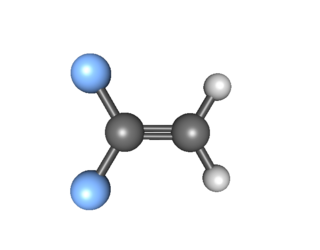
Halothane, sold under the brand name Fluothane among others, is a general anaesthetic. It can be used to induce or maintain anaesthesia. One of its benefits is that it does not increase the production of saliva, which can be particularly useful in those who are difficult to intubate. It is given by inhalation.

The organic compound 1,1,1-trichloroethane, also known as methyl chloroform and chlorothene, is a chloroalkane with the chemical formula CH3CCl3. It is an isomer of 1,1,2-trichloroethane. A colourless and sweet-smelling liquid, it was once produced industrially in large quantities for use as a solvent. It is regulated by the Montreal Protocol as an ozone-depleting substance and as such use has declined since 1996. Trichloroethane should not be confused with the similar-sounding trichloroethene which is also commonly used as a solvent.
In chemical nomenclature, the IUPAC nomenclature of organic chemistry is a method of naming organic chemical compounds as recommended by the International Union of Pure and Applied Chemistry (IUPAC). It is published in the Nomenclature of Organic Chemistry. Ideally, every possible organic compound should have a name from which an unambiguous structural formula can be created. There is also an IUPAC nomenclature of inorganic chemistry.

A gas duster, also known as tinned wind or compressed air, is a product used for cleaning or dusting electronic equipment and other sensitive devices that cannot be cleaned using water.
Trifluoroethane may refer to either of two isomeric fluorocarbons which differ by the location of attachment of the fluorine atoms:
IARC group 3 substances, chemical mixtures and exposure circumstances are those that can not be classified in regard to their carcinogenicity to humans by the International Agency for Research on Cancer (IARC). This category is used most commonly for agents, mixtures and exposure circumstances for which the level of evidence of carcinogenicity is inadequate in humans and inadequate or limited in experimental animals. Exceptionally, agents (mixtures) for which the evidence of carcinogenicity is inadequate in humans, but sufficient in experimental animals may be placed in this category when there is strong evidence that the mechanism of carcinogenicity in experimental animals does not operate in humans. Agents, mixtures and exposure circumstances that do not fall into any other group are also placed in this category.

2,2-Dichloro-1,1,1-trifluoroethane or HCFC-123 is considered as an alternative to CFC-11 in low pressure refrigeration and HVAC systems, and should not be used in foam blowing processes or solvent applications. It is also the primary component of the Halotron I fire-extinguishing mixture.

1,1,1-Trifluoroethane, or R-143a or simply trifluoroethane, is a hydrofluorocarbon (HFC) compound that is a colorless gas. It should not be confused with the much more commonly used HFC gas R-134a, nor confused with the isomeric compound 1,1,2-trifluoroethane. 1,1,1-Trifluoroethane has a critical temperature of 73 °C.
1,1,2-Trichloro-1,2,2-trifluoroethane, also called trichlorotrifluoroethane or CFC-113, is a chlorofluorocarbon. It has the formula Cl2FC−CClF2. This colorless, volatile liquid is a versatile solvent.
The molecular formula C2HCl2F3 (molar mass: 152.93 g/mol, exact mass: 151.9407 u) may refer to:
Trichlorotrifluoroethane may refer to:

1,1-Difluoroethylene, also known as vinylidene fluoride, is a hydrofluoroolefin. This colorless, flammable gas is a difluorinated derivative of ethylene. Global production in 1999 was approximately 33,000 metric tons. It is primarily used in the production of fluoropolymers such as polyvinylidene fluoride and FKM.
1,1,1-Trichloro-2,2,2-trifluoroethane, also called Asymmetrical trichlorotrifluoroethane or CFC-113a, is a chlorofluorocarbon (CFC) with the formula CCl3CF3.
The molecular formula C2Cl3F3 (molar mass: 187.38 g/mol, exact mass: 185.9018 u) may refer to:

1,2-Dichloro-1,1,2-trifluoroethane is a volatile liquid chlorofluoroalkane composed of carbon, hydrogen, chlorine and fluorine, and with structural formula CClF2CHClF. It is also known as a refrigerant with the designation R-123a.

Trifluoroacetonitrile is a nitrile with the chemical formula CF3CN.

Chlorotrifluoropropane is a hydrochlorofluorocarbon with the chemical formula C3H4F3Cl). It is a volatile derivative propane. It appears as a colourless, odorless non-flammable liquid.

1,1-Dichlorotetrafluoroethane is a chlorofluorocarbon also known as CFC-114a or R114a by American Society of Heating, Refrigerating, and Air Conditioning Engineers. It has two chlorine atoms on one carbon atom and none on the other. It is one of two isomers of dichlorotetrafluoroethane, the other being 1,2-dichlorotetrafluoroethane, also known as CFC-114.

1,1,2-Trifluoroethane or R-143, is a hydrofluorocarbon with formula CH2FCHF2. It is a colourless gas at room temperature. It is an asymmetrical isomer of 1,1,1-trifluoroethane. 1,1,2-Trifluoroethane has a global warming potential of 397 for 100 years.












